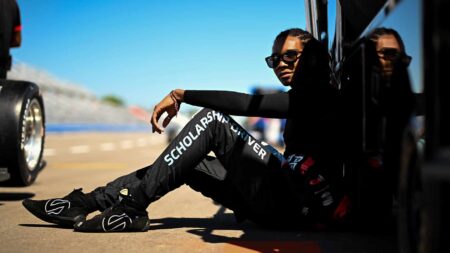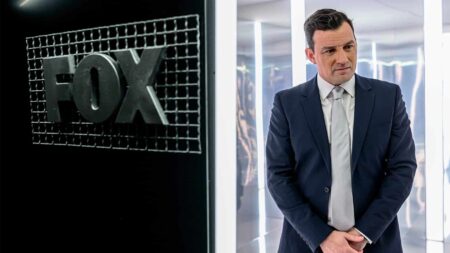
Lundgaard: McLaren can make history with F1/IndyCar double win
Christian Lundgaard is McLaren's new IndyCar star – and wants to make history by helping the team win both in F1 at Bahrain and at Long Beach Stateside on the same day
Jim Smith had had a sheltered 1940s-50s upbringing on the remote New South Wales dairy farm run by his Methodist parents. He seldom went anywhere else other than to the local school or to the Sunday school.
So, after a four-year fitting-and-machining apprenticeship at the huge Broken Hill Proprietary steel works in Newcastle, he… ran away to sea.
It was April Fools’ Day, 1962.
“For me, there has to be two parts to any job: brain and hands,” he says. “I got that in spades as a marine engineer. To me, motor racing was mainly about hands.”

He is referring to a short but intense spell in the sport during which he was mechanic to a victorious Jim Clark at Indianapolis in 1965: “Where do you go from there?”
He was back at sea within two years – and stayed there until the end of 2012.
“I’d missed it,” he explains. “I returned to Australia on the Oriana at the end of 1966 – for my sister’s wedding – and looked around for work, but nothing else appealed. I enjoyed the life at sea. It ticked all my boxes.
“To be honest, I was on a working trip around the world when I blundered into motor racing and [by mid-1965] felt that I had nowhere else to go at Team Lotus. I could see nothing in store for its Indy team except the [Group 7 sports-prototype] Lotus 30, which didn’t excite me, and there appeared to be no prospect of getting a chief mechanic’s job in the near future.
“Plus, I couldn’t see myself living in England for any great length of time – and I had a job offer in the US.
“I was, if anything, overqualified, and the pay in the UK was terrible – £12-14 per week – especially when you took the hours into account. Thus the sport tended to attract only enthusiasts. Though the money was better in the US, it was the prospect of working and travelling there that attracted me.

The start, 1964. Photo: IMS
“Things soon changed within Team Lotus and my position would have been different, had I stayed. But I don’t regret what I did. Not at all.”
He resigned just a few weeks after Indy and re-crossed the Atlantic for similarly brief and exciting spells with George Bignotti at Mecom Racing – where he ran Jackie Stewart’s first test at Indy – and building two Shrike Indycars for Parnelli Jones and looking after them during the 1966 USAC season.
Though he preferred American racing – “One big happy family moving freely between garages” – Jim realised that his motor sport moment had gone.
But what a moment!
He had rejoined Lotus – the first stint, to his surprise and disappointment, had been with its road car division – on July 13, 1964. He did so at the behest of fellow Australian Ray Parsons, a driver/mechanic/engineer.
“I did two return trips to Hong Kong on [cargo vessel] MV Salmara,” says Jim. “At the end of the first I went into the pub frequented by Team Lotus staff and Ray was at the bar. He asked if I wanted a job and I had to tell him that I’d just signed [Seamen’s] Articles and couldn’t accept his offer.
“I said, ‘Look, I’ll be back in five months.’

AJ Foyt at Milwaukee, 1964
“Five months later I walked into the same pub – and Ray was at the bar. At first I refused his offer – I had three months leave due me – but then he revealed that the job was with the Formula 1 team.
“‘Okay, you’ve got me!’ I said.
“I left the Salmara on the Friday and started at Team Lotus the following Monday. I didn’t jump ship, as claimed by [competitions manager] Andrew Ferguson [in his book Team Lotus: the Indianapolis Years], but I did forget to resign from P&O.”
Three days later he set off for the non-championship F1 Solitude Grand Prix.
A fortnight after that he was in America mechanicking Lotus 34 Indycars for AJ Foyt and Jones at Milwaukee and Clark and Jones at Trenton, New Jersey. Jones won both races.
Jim, meanwhile, had caught Colin Chapman’s eye – for reasons both good and bad.
“It was stinking hot at Trenton. Our transporter was parked on the track under a light and we were working out of the back of it. It was rudimentary, I can assure you.

“I’d been on the go all day. I still had my seafaring beard. My overalls were undone to my navel. And, being a farm boy, I’d kicked off my shoes and was working barefoot.
“Just then this bloody great Lincoln pulled up. Inside were Chapman and Ford’s [US racing director] Leo Beebe: ‘Colin, you seem to be scraping the bottom of the barrel with these Bohemian-types.’
“There were two parts to Colin and I: my personal life as an Australian, and my mechanical skills. He appreciated the latter and was guided by that. We never had words, work-wise; he left it to [chief mechanic] Dave Lazenby to talk to me about my liking for an occasional beer.”
Chapman’s appreciation of him would lead to a sudden and unexpected promotion for (a clean-shaven) Jim at Indy the following year.
“His first words to me when he walked into the garage were, ‘Jim, you’re going to look after Jimmy’s car.’ That must have upset [mechanic] Mike Underwood: I’d got the job he assumed was his.
Only a few days before, Dave had said: ‘Right! Mike, you look after Jimmy’s car. Graham [Clode], you look after Bobby’s [Johns, Clark’s team-mate]. Jim, you work on both, and do the engine and gearbox adjustments.’”

Bobby Johns
“Colin never explained the change and, I presume, as far as Jimmy and Dave were concerned, it was his decision. Whether they’d talked about it, I don’t know, but there’s a pretty good chance that they would have.
“I believe that the result vindicated the decision.”
Jim had helped build the first two of the three Type 38 Indycars in the UK – running brake, clutch, oil and water lines through, putting fuel tanks in and fitting engine, gearbox and suspension to a bare tub – before jetting to the US.
“I flew alone to Indy to prepare the garage, before leaving for Trenton in a new Ford pick-up on 14 April, collecting a $15 speeding fine on the way. The next day I rented a truck – never having driven one before – and on Good Friday set out for New York’s JFK airport to collect two 38s and transfer them to Trenton.
“It took two trips. Mike had turned up by the time of the second but didn’t want to drive because he was tired having flown all day. I was still the dogsbody and had to put up with that sort of stuff. I was not yet assigned to a car and worked as required.

“I remember little of that Trenton test except for Roger McCluskey’s crash [in chassis 38/2] and the New York Times article that ended something like: A mechanic putting the brake pedal in back-to-front didn’t help.
“The front of the cockpit was enclosed and access was difficult, especially with the driver in situ. Roger, sitting in the car, asked to have a pedal altered, so I disconnected it, tied a length of locking wire to it and retrieved it. I then altered and refitted it.
“Back-to-front.
“So I just lowered it down, turned it around and fixed it into place. No big thing.
“A few laps later Roger slid into the wall. He apologised about the article, exonerated me and admitted that he’d just lost it. When I next saw the journalist I promptly told him where to go, in good Aussie vernacular.
“After the Trenton test, 38/1 was flown to Indy airport, about 12 miles from the Speedway, and Mike, Graham and myself went to collect it. A short cargo strap was tied from the pick-up’s towbar to the front-right wishbone, and then I – still the new kid on the block – was told to get into the Lotus.
“Mike jumped in the pick-up and took off down the freeway at a rate of knots. Somehow we made it to the Team Lotus garage in one piece. I shudder to think what would have happened if he had hit the brakes.

A note from AJ
“The McCluskey crash had left the team behind the eight ball and mechanics Bob Dance and Bob Sparshott were drafted to help complete the replacement car. Therefore, unless I needed a hand to change an engine or something, I was left on my own to look after Jimmy’s car. That arrangement suited me.
“It was a full-time job. Though the car went very well from the start, it’s not true that it ran non-stop all month – and changing an engine on that thing was abysmal. There was only a narrow gap between the engine and the centre bulkhead and the mounting bolts and water and oil connections were within it.
“I had words with [designer] Len Terry about that, and he said something like ease of work having to give way to function, or some such bloody thing.
“What’s more, the engine block that Team Lotus had been given as a template for the mounts was a 1964 unit. The ’65 casting was a bit different, so you’d spend two or three hours with a burr-grinder making it fit.
“An engine-change took about 18 hours.
“And once you removed one you didn’t get it back, because there was a pool of them.
“We went through at least three. One of which we blew up on purpose…”
Stay tuned for part two, coming on May 28

Christian Lundgaard is McLaren's new IndyCar star – and wants to make history by helping the team win both in F1 at Bahrain and at Long Beach Stateside on the same day

Louis Foster starts his IndyCar journey this weekend in St Petersburg – can he emulate other British heroes like Nigel Mansell and Dan Wheldon?

Myles Rowe has rocketed through IndyCar's junior ladder with a story like no other – he tells James Elson why this upcoming year is more important than ever

Drive to Survive star Will Buxton has made the jump across the Atlantic to front Fox's new IndyCar coverage – he explained to James Elson why he thinks the championship is the most exciting series out there